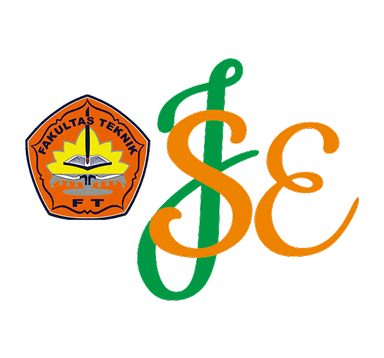Sintesis dan Karakterisasi Membran Ramah Lingkungan dari Limbah Styrofoam dengan Penambahan Biochar
Keywords:
styrofoam waste, membrane, biochar, hydrophilicity, porosityAbstract
Styrofoam waste is increasingly found in Indonesia as packaging, craft materials, decorations, construction materials, etc. Styrofoam consists of 90-95% polystyrene and 5-10% n-butane gas. The production of membranes is one of the solutions to reduce Styrofoam waste through the phase inference method. Polymer membranes in general have poor physical properties. However, this problem can eventually be overcome by adding blends. The addition of biochar has the potential to improve the compatibility between biochar particles and polystyrene. The membrane fabrication results are compared to determine the variation of biochar addition and thickness that has the best hydrophilic properties until the membrane has a contact angle <90o and high porosity. Based on the results of porosity and contact angle analysis on PS-biochar membrane, the best concentration and thickness ratio for membrane fabrication is 2:28 (%Wt) 0.13 mm thickness with a contact angle value of 79°, which means the membrane is hydrophilic as evidenced by the size of contact angle <90° and porosity of 33%. In the results of FTIR (Fourier Transform Infrared Spectroscopy) analysis on the biochar polystyrene membrane there is a peak absorption wave at 1800 which is the absorption of the C=O group which is the absorption of the functional group of biochar.
References
[1] B. Triyono, D. Muliastri, and D. A. Eka Septiyani, “The Characterization of Mechanical and Chemical Properties of Recycled Styrofoam Waste Employing Extrusion Process,” 2023. [Online]. Available: https://jurnal.polines.ac.id/index.php/rekayasa
[2] Nurillahi Febria Leswana, Dwi Siswanta, and Adhitasari Suratman, “Synthesis Polyelectrolyte Complex Membrane Polystyrene Sufonate-Chitosan from Styrofoam Waste as The Adsorbent for Cu(II) and Ni(II) Metal,” Jurnal Farmasi Etam (JFE), vol. 1, no. 1, pp. 10–25, Jun. 2021, doi: 10.52841/jfe.v1i1.173.
[3] R. Muhamad Iqbal, S. Namarito Simarmata, E. Roulina Simanjuntak, W. Nugroho, L. Rosmainar Tambunan, and J. Kimia, “Review: Pengembangan Mixed Matrix Membrane Untuk Pemisahan Gas CO2/CH4 Recent Development of Mixed Matrix Membrane for CO2/CH4 Separation,” 2020.
[4] X. He, T. Wang, J. Huang, J. Chen, and J. Li, “Fabrication and characterization of superhydrophobic PDMS composite membranes for efficient ethanol recovery via pervaporation,” Sep Purif Technol, vol. 241, Jun. 2020, doi: 10.1016/j.seppur.2020.116675.
[5] F. Verheijen, S. Jeffery, A. C. Bastos, M. Van Der Velde, and I. Diafas, “Biochar Application to Soils A Critical Scientific Review of Effects on Soil Properties, Processes and Functions”, doi: 10.2788/472.
[6] C. J. Atkinson, J. D. Fitzgerald, and N. A. Hipps, “Potential mechanisms for achieving agricultural benefits from biochar application to temperate soils: A review,” Dec. 2010. doi: 10.1007/s11104-010-0464-5.
[7] F. A. H. Juber, Z. A. Jawad, B. L. F. Chin, S. P. Yeap, and T. L. Chew, “The prospect of synthesis of PES/PEG blend membranes using blend NMP/DMF for CO2/N2 separation,” May 01, 2021, Springer Science and Business Media B.V. doi: 10.1007/s10965-021-02500-6.
[8] M. M. Heravi, M. Ghavidel, and L. Mohammadkhani, “Beyond a solvent: Triple roles of dimethylformamide in organic chemistry,” 2018, Royal Society of Chemistry. doi: 10.1039/c8ra04985h.
[9] Y. Tang et al., “A review on models and simulations of membrane formation via phase inversion processes,” Dec. 15, 2021, Elsevier B.V. doi: 10.1016/j.memsci.2021.119810.
[10] * Sofyana, S. Aprilia, and M. Assaki, “Karakteristik Membran Selulosa Triasetat Yang Diprepasi Secara Inversi Fasa Presipitasi Imersi,” 2020.
[11] S. D. Nurherdiana et al., “Characteristics Of Styrofoam Waste-Based Membrane Through Vapor and Liquid-Induced Phase Inversion Process,” 2023.
[12] D. Hermanto, M. Mudasir, D. Siswanta, and B. Kuswandi, “Synthesis of Alginate-Chitosan Polyelectrolyte Complex (PEC) Membrane and Its Physical-Mechanical Properties,” Jurnal Kimia Sains dan Aplikasi, vol. 22, no. 1, pp. 11–16, Jan. 2019, doi: 10.14710/jksa.22.1.11-16.
[13] M. Elma, P. Pengelolaan Jurnal dan Penerbitan Unlam Jl HHasan Basry, and K. Tangi, Proses Pemisahan Menggunakan Teknologi Membran. Lambung Mangkurat University Press, 2016.
[14] A. Jalali, A. Shockravi, V. Vatanpour, and M. Hajibeygi, “Preparation and characterization of novel microporous ultrafiltration PES membranes using synthesized hydrophilic polysulfide-amide copolymer as an additive in the casting solution,” Microporous and Mesoporous Materials, vol. 228, pp. 1–13, Jul. 2016, doi: 10.1016/j.micromeso.2016.03.024.
[15] U. Fathanah, I. Machdar, M. Riza, N. Arahman, M. R. Lubis, and M. Yusuf, “The Improvement of Hydrophilic Property of Polyethersulfone Membrane with Chitosan as Additive,” Jurnal Rekayasa Kimia & Lingkungan, vol. 15, no. 1, pp. 53–61, Mar. 2020, doi: 10.23955/rkl.v15i1.15916.
[16] S. Gu, L. Li, F. Liu, and J. Li, “Biochar/Kevlar nanofiber mixed matrix nanofiltration membranes with enhanced dye/salt separation performance,” Membranes (Basel), vol. 11, no. 6, 2021, doi: 10.3390/membranes11060443.
[17] A. Y. Elnour et al., “Effect of pyrolysis temperature on biochar microstructural evolution, physicochemical characteristics, and its influence on biochar/polypropylene composites,” Applied Sciences (Switzerland), vol. 9, no. 6, 2019, doi: 10.3390/app9061149.
[18] J. Fang, Y. Xuan, and Q. Li, “Preparation of polystyrene spheres in different particle sizes and assembly of the PS colloidal crystals,” Sci China Technol Sci, vol. 53, no. 11, pp. 3088–3093, 2010, doi: 10.1007/s11431-010-4110-5.
[19] R. Ariadi Lusiana and N. Basid Adiwibawa Prasetya, “Indonesian Journal of Chemical Science Pengaruh Penambahan Aditif terhadap Karakterisasi Fisikokimia Membran Polisulfon,” 2020. [Online]. Available: http://journal.unnes.ac.id/sju/index.php/ijcs
[20] A. S. Auliya and N. Kusumawati, “Optimasi Ketebalan Cetak Pada Preparasi Membran Polyetherimide (PEI).”
[21] R. S. Hebbar, A. M. Isloor, and A. F. Ismail, “Contact Angle Measurements,” in Membrane Characterization, Elsevier Inc., 2017, pp. 219–255. doi: 10.1016/B978-0-444-63776-5.00012-7.
[22] M. Adamczak, G. Kamińska, and J. Bohdziewicz, “Application of waste polymers as basic material for ultrafiltration membranes preparation,” Water (Switzerland), vol. 12, no. 1, Jan. 2020, doi: 10.3390/w12010179.
[23] A. L. Ahmad, T. A. Otitoju, and B. S. Ooi, “Hollow fiber (HF) membrane fabrication: A review on the effects of solution spinning conditions on morphology and performance,” Feb. 25, 2019, Korean Society of Industrial Engineering Chemistry. doi: 10.1016/j.jiec.2018.10.005.
Downloads
Published
Issue
Section
License
Copyright (c) 2024 Nur Fadhila, Yasmine Nur Rahmawati, Nana Dyah Siswati (Author)

This work is licensed under a Creative Commons Attribution 4.0 International License.












